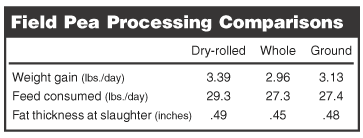Fargo, North Dakota
August 18, 2005
Field peas need to go through only a minimal
amount of processing to be effective as a protein supplement in
diets for feedlot heifers, a
North Dakota State University (NDSU) study shows.
Researchers at NDSU's Carrington Research Extension Center found
that the test heifers fed a corn-based diet that included
dry-rolled peas gained weight the fastest, consumed the most
feed and were the fattest at slaughter.
The researchers compared dry-rolled, whole and ground peas. The
dry-rolling process breaks the peas into small pieces, which are
easier for cattle to digest, but not so small that they will
create the digestive upsets that finely ground peas can cause.
Dry-rolled peas also produced the best gains in creep-fed
calves, compared with ground or whole peas, when researchers
added peas as 40 percent of the feed ration formula. Researchers
are continuing the creep feed studies with an evaluation of
pelleted creep feeds that include peas.
Studies like this are important because North Dakota has a
growing supply of field peas available for use in cattle diets
at good prices, according to Vern Anderson, an animal scientist
and principal investigator in the field pea research.
"There is a significant supply of peas available this year and
prices are very competitive with other feeds," he says. The
North Dakota Dry Pea and Lentil Association can help interested
feeders find a source of peas.
North Dakota producers planted 530,000 acres of field peas this
year, up from 310,000 acres last year, and they expect to plant
even more next year. The state is the nation's No. 1 producer of
field peas.
 "Field
peas support excellent animal performance and can be used in a
wide variety of livestock diets," Anderson says. "Peas are an
extremely attractive feed, especially for creep feeds and
receiving diets. We have had great success using peas in rations
for growing and finishing cattle, winter supplementation for
cows and also for bull rations." "Field
peas support excellent animal performance and can be used in a
wide variety of livestock diets," Anderson says. "Peas are an
extremely attractive feed, especially for creep feeds and
receiving diets. We have had great success using peas in rations
for growing and finishing cattle, winter supplementation for
cows and also for bull rations."
Blaine Schatz, director of the Carrington Research Extension
Center, says pea production is increasing because producers are
beginning to realize that field peas grow well in the northern
Great Plains and work well in their crop rotation. And, as field
peas become more widely known and accepted as feed, producers
will be able to market their product more readily to regional
livestock producers.
Field peas, also known as dry peas, are marketed as a dry,
shelled product for human food or as livestock feed. They differ
from fresh peas, which are marketed as a fresh or canned
vegetable for human consumption.
Research on field peas is continuing at the Carrington Research
Extension Center on stepped levels of peas included in feedlot
rations. That research will culminate in a taste panel
evaluation of beef. NDSU researchers soon plan to produce a
publication summarizing field pea research for beef cattle. |